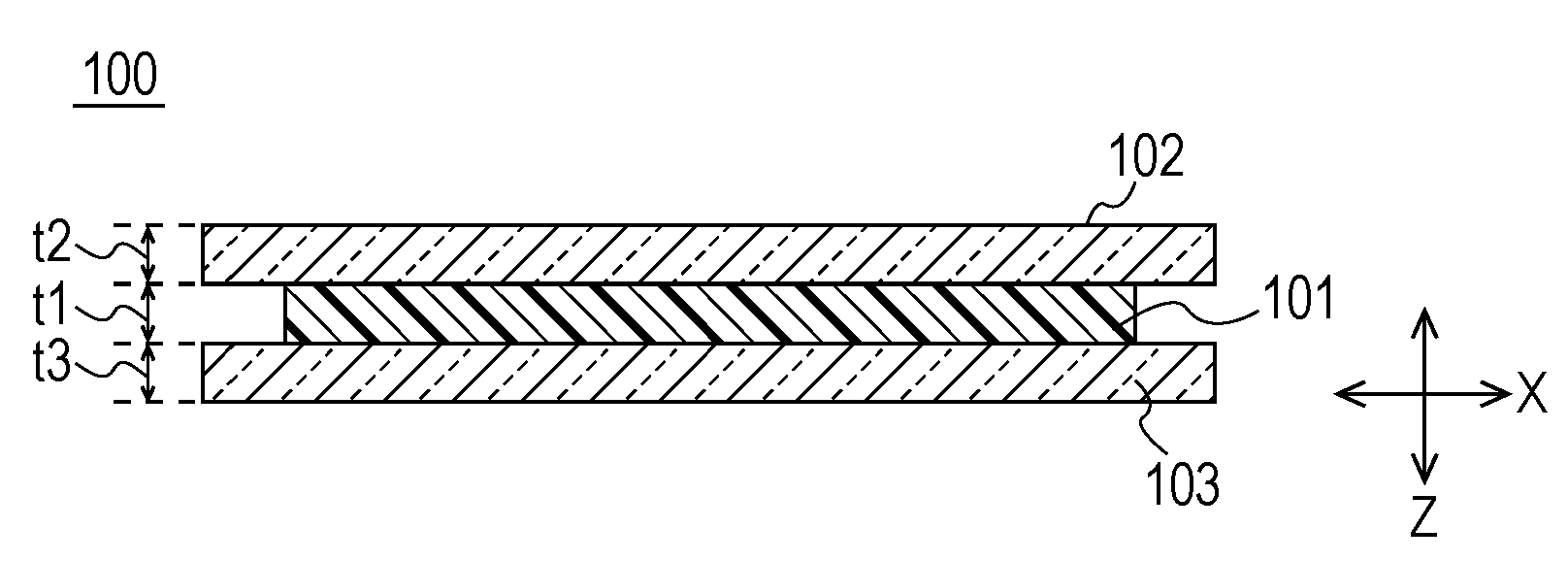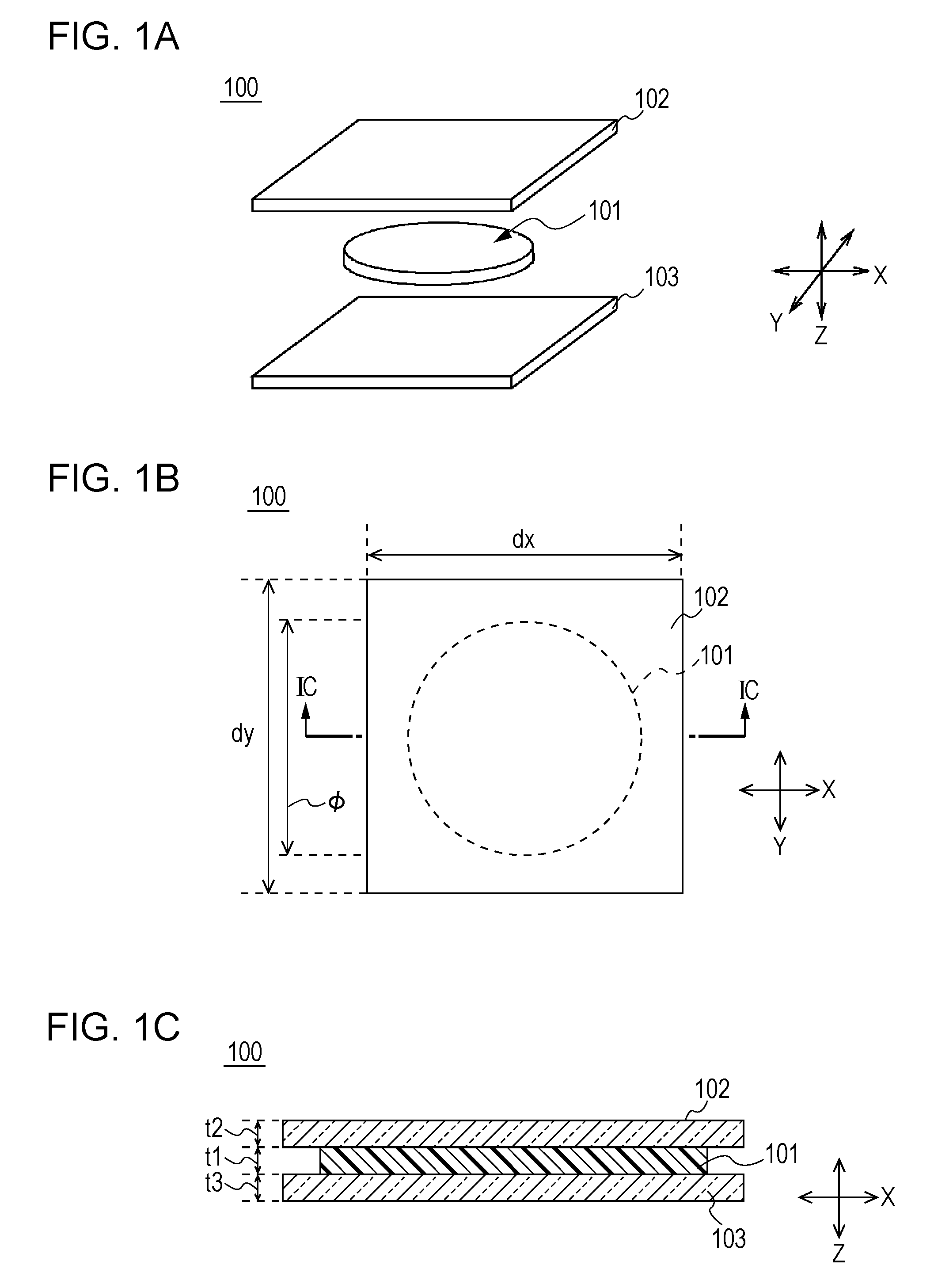Optical information recording medium
a technology of optical information and recording medium, which is applied in the field of optical information recording medium, can solve the problems of complex optical system, inability to achieve easy implementation in practice, and inability to significantly increase the absorption factor in the vicinity of the focus, so as to achieve efficient absorbing and improve the recording rate
- Summary
- Abstract
- Description
- Claims
- Application Information
AI Technical Summary
Benefits of technology
Problems solved by technology
Method used
Image
Examples
embodiments
1. Structure of Optical Information Recording Medium
[0031]As shown in FIGS. 1A to 1C, an optical information recording medium 100 is formed, as a whole, such that a recording layer 101 is provided between substrates 102 and 103 so as to function as a medium to record information. The shape of the optical information recording medium 100 is not particularly limited, and of course, a rectangular shape as shown in FIG. 1 may be formed, and a disc having a diameter of 120 mm, such as a general optical disc including a BD (Blu-ray Disc, registered trademark) and a DVD (digital versatile disc), may also be formed to have a clamping hole at the center thereof.
[0032]The substrates 102 and 103 are formed of glass so as to transmit light at a high rate. In addition, the substrates 102 and 103 are formed to have a square shape or a rectangular shape in which a length dx in an X direction and a length dy in a Y direction are set to approximately 50 mm, and in which thicknesses t2 and t3 are set...
example 1
4-1. Example 1
[0112][4-1-1. Formation of Samples]
[0113]Samples S1 to S4 were each formed as the optical information recording medium 100 under the following conditions. In addition, as comparative samples, Comparative Samples R1 to R4 were each also formed as the optical information recording medium 100.
[0114]Four types of photopolymerization initiators (shown below) used in Example 1 are represented by photopolymerization initiators A, B, D, and E. In addition, besides the photopolymerization initiators, a Lewis acid compound C was also used. As the photopolymerization initiators and the Lewis acid compound, commercially available compounds were used. Since the photopolymerization initiators and the Lewis acid compound were commercially available compounds, various additives might also be contained in some cases besides the compounds shown below.
[0115]Photopolymerization initiator A: cumyltolyliodonium tetrakis(pentafluorophenyl)borate (General Formula (2))
[0116]Photopolymerization...
example 2
4-2. Example 2
[0170][4-2-1. Formation of Samples]
[0171]In a manner similar to that in Example 1, Samples S11 to S14 were formed as the optical information recording medium 100. In addition, as comparative samples, Comparative Samples R11 to R13 were also formed as the optical information recording medium 100.
[0172]In Example 2, besides the photopolymerization initiators A, D, and E used in Example 1, one type of photopolymerization initiator (shown below) was used and was referred to as a photopolymerization initiator F.
[0173]Photopolymerization Initiator F: bis(t-butyl phenyl)iodonium hexafluoroantimonate (General Formula (6))
[0174]In addition, a fluorene difunctional epoxy is a monomer having the fluorene structure shown by the general formula (1) and two functional epoxy groups (EX1020 manufactured by Osaka Gas Chemicals Co., Ltd.).
[0175]In the following table, monomers, photopolymerization initiators, and the amounts thereof used for the liquid materials M1 of Samples S11 to S14...
PUM
| Property | Measurement | Unit |
|---|---|---|
| thickness | aaaaa | aaaaa |
| thickness | aaaaa | aaaaa |
| temperature | aaaaa | aaaaa |
Abstract
Description
Claims
Application Information
 Login to View More
Login to View More - R&D
- Intellectual Property
- Life Sciences
- Materials
- Tech Scout
- Unparalleled Data Quality
- Higher Quality Content
- 60% Fewer Hallucinations
Browse by: Latest US Patents, China's latest patents, Technical Efficacy Thesaurus, Application Domain, Technology Topic, Popular Technical Reports.
© 2025 PatSnap. All rights reserved.Legal|Privacy policy|Modern Slavery Act Transparency Statement|Sitemap|About US| Contact US: help@patsnap.com



